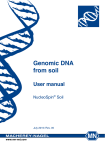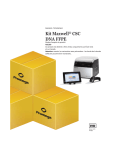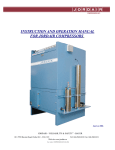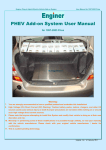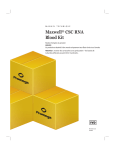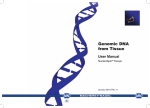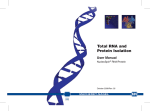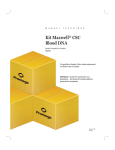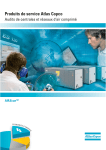Download Genomic DNA from Soil
Transcript
Genomic DNA from Soil User Manual NucleoSpin® Soil January 2010 / Rev. 01 MACHEREY-NAGEL Genomic DNA Purification from Soil Protocol-at-a-glance (Rev. 01) NucleoSpin® Soil 1 Prepare sample NucleoSpin® Soil Bead Tube 250 – 500 mg sample material 700 µl SL1 or SL2 2 Adjust lysis conditions 3 Sample lysis Horizontally vortex 5 min at RT or use other homogenizers according to manufacturers protocol 4 Precipitate contaminants 11,000 x g, 2 min 150 µl Enhancer SX 150 µl SL3 Vortex 5 s 0 – 4°C, 5 min 11,000 x g, 1 min 5 Filter lysate Load supernatant on NucleoSpin® Inhibitor Removal Column 11,000 x g, 1 min 6 Adjust binding conditions 250 µl SB Vortex 5 s 7 Bind DNA Load 550 µl sample on NucleoSpin® Soil Column 11,000 x g, 1 min Load remaining sample 11,000 x g, 1 min 8 9 10 Wash silica membrane Dry silica membrane Elute DNA 1st 500 µl SB 11,000 x g, 30 s 2nd 550 µl SW1 11,000 x g, 30 s rd 3 700 µl SW2 Vortex 2 s 11,000 x g, 30 s 4th 700 µl SW2 Vortex 2 s 11,000 x g, 30 s 11,000 x g, 2 min 30 – 100 µl SE RT, 1 min 11,000 x g, 1 min MACHEREY-NAGEL GmbH & Co. KG • Neumann-Neander-Str. 6-8 • D-52355 Düren • Germany Tel.: +49 (0) 24 21 969 270 • www.mn-net.com • e-mail: [email protected] MN Genomic DNA from Soil Table of contents 1 2 Components 4 1.1 Kit contents 4 1.2 Reagents, consumables, and equipment to be supplied by user 5 1.3 About this User Manual 5 Product description 6 2.1 The basic principle 6 2.2 Kit specifications 6 2.3 Relevance of humic substances as PCR inhibitors 7 2.4 Amount of starting material 8 2.5 Choice of lysis buffer 8 2.6 Mechanical sample lysis 10 2.7 Repeated extraction 10 2.8 Elution procedures 10 2.9 How to interpret DNA yield and purity from UV-VIS 11 3 Storage conditions and preparation of working solutions 13 4 Safety instructions – risk and safety phrases 14 5 Protocol – Purification of DNA from soil and sediment 15 6 Appendix 19 6.1 Troubleshooting 19 6.2 Ordering information 21 6.3 Product use restriction / warranty 21 MACHEREY-NAGEL – 01 / 2010, Rev. 01 3 Genomic DNA from Soil 1 Components 1.1 Kit contents NucleoSpin® Soil 10 preps 50 preps 250 preps 740780.10 740780.50 740780.250 Lysis Buffer SL1 30 ml 2 x 30 ml 250 ml Lysis Buffer SL2 30 ml 2 x 30 ml 250 ml Lysis Buffer SL3 5 ml 15 ml 50 ml Enhancer SX 3 ml 10 ml 50 ml Binding Buffer SB 10 ml 2 x 25 ml 2 x 125 ml Wash Buffer SW1 6 ml 30 ml 2 x 75 ml Wash Buffer SW2 (Concentrate)* 6 ml 20 ml 2 x 50 ml Elution Buffer SE** 5 ml 15 ml 30 ml NucleoSpin® Bead Tubes 10 50 250 NucleoSpin® Inhibitor Removal Columns (red rings) 10 50 250 NucleoSpin® Soil Columns (green rings) 10 50 250 Collection Tubes (2 ml) 10 50 250 Collection Tubes (2 ml, lid) 10 50 250 User Manual 1 1 1 Cat. No. * For preparation of working solutions and storage conditions see section 3. ** Composition of Elution Buffer SE: 5 mM Tris/HCl, pH 8.5 4 MACHEREY-NAGEL – 01 / 2010, Rev. 01 Genomic DNA from Soil 1.2 Reagents, consumables, and equipment to be supplied by user Reagents • 96 – 100% ethanol Consumables • 1.5 ml microcentrifuge tubes • Disposable pipette tips Equipment • Manual pipettors • Centrifuge for microcentrifuge tubes • Equipment for sample disruption and homogenization (see section 2.6) • Personal protection equipment (e.g., lab coat, gloves, goggles) 1.3 About this User Manual It is strongly recommended that first-time users of the NucleoSpin® Soil kit read the detailed protocol sections of this User Manual. Experienced users, however, may refer to the Protocol-at-a-glance instead. The Protocol-at-a-glance is designed to be used only as a supplemental tool for quick referencing while performing the purification procedure. All technical literature is available on the internet at www.mn-net.com. MACHEREY-NAGEL – 01 / 2010, Rev. 01 5 Genomic DNA from Soil 2 Product description 2.1 The basic principle The sample material is resuspended in Lysis Buffer SL1 or SL2, supplemented with the Enhancer SX, and mechanically disrupted using ceramic beads. Proteins and PCR inhibitors are precipitated with Lysis Buffer SL3 and subsequently pelleted by centrifugation together with the ceramic beads and undissolved sample material. The supernatant is taken off and cleared by passing it through a NucleoSpin® Inhibitor Removal Column. DNA binding conditions are then adjusted by addition of Binding Buffer SB to the flowthrough and the lysate is loaded onto a NucleoSpin® Soil Column. Residual humic substances, especially humic acids, and other PCR inhibitors are removed by efficient washing with Binding Buffer SB and Wash Buffers SW1 / SW2. After a drying step, ready-to-use DNA can be eluted with Elution Buffer SE (5 mM Tris/ HCl, pH 8.5). 2.2 6 Kit specifications • The NucleoSpin® Soil kit is designed for the isolation of high molecular weight genomic DNA from microorganisms like Gram-positive and Gram-negative bacteria, archaea, fungi, and algae in soil, sludge, and sediment samples. • The kit offers two special lysis buffers, Buffer SL1 and Buffer SL2, which can be combined with the chemical additive Enhancer SX to guarantee highest possible yields with excellent purity for all types of sample material. • Efficient mechanical lysis of the sample material is achieved by bead beating using the ceramic NucleoSpin® Beads. • The optimized buffer chemistry and the NucleoSpin® Inhibitor Removal Column completely remove humic substances and other PCR inhibitors typically present in soil and sediment samples. • The eluted DNA is ready-to-use for all standard downstream applications. In most cases the concentrated DNA can be used as PCR template without further dilution for highest sensitivity. MACHEREY-NAGEL – 01 / 2010, Rev. 01 Genomic DNA from Soil Table 1: Kit specifications at a glance Parameter NucleoSpin® Soil Sample size Up to 500 mg soil or sediment Typical yield 2 – 10 µg Elution volume Binding capacity 50 µg Preparation time < 90 min (10 preps) Format 2.3 30 – 100 µl Mini spin column Relevance of humic substances as PCR inhibitors Humic substances are produced by bacteria, fungi and, protozoa in soil, sediments and waters during the degradation of plant or other organic matter. They consist of very high molecular weight compounds with undefined structures. Building blocks are mainly heterocyclic aromatic compounds that are linked by ether or ethoxy groups and which carry hydroxyl-, methoxy-, carbonyl-, or carboxyl groups. According to their solubility in water they are divided into humin, humic acids, and fulvic acids. The completely insoluble and black humin has an average molecular weight of around 300,000 g / mol. The dark brown to grey colored humic acids are slightly smaller. They carry a lot of hydroxyl and carboxyl groups and are therefore mainly soluble at neutral or alkaline pH. The only slightly yellow to light-brown colored fulvic acids with an average molecular weight of 2,000 g / mol are soluble under alkaline as well as under acidic conditions. Due to the high molecular weight and the mainly polyanionic nature of humic substances most purification methods do not distinguish between these molecules and DNA. For the same reason they act as extremely potent PCR inhibitors. Even smallest amounts of humic substances can inhibit for example DNA polymerases or restriction enzymes and result in a complete failure of enzymatic downstream applications. Frequently, the problem is circumvented by dilution of the isolated DNA prior to PCR analysis. However, this results in a significantly reduced sensitivity because low abundance DNA may be lost completely. Thus, highest DNA yields with as little PCR inhibitor contaminations as possible are of utmost importance for any DNA analysis of soil samples. MACHEREY-NAGEL – 01 / 2010, Rev. 01 7 Genomic DNA from Soil 2.4 Amount of starting material NucleoSpin® Soil is suitable for processing 250 – 500 mg of sample material. However, do not fill the NucleoSpin® Bead Tube higher than the 1 ml mark (including the ceramic beads) to ensure sufficient head space for an efficient mechanical disruption. Usually a reduction of starting material also helps to improve the lysis efficiency and to increase the purity of the DNA. Very dry material can soak up large volumes of lysis buffer. In this case, either reduce the amount of sample material or add additional lysis buffer up to the 1.5 ml mark of the NucleoSpin® Bead Tube. If possible remove foreign material like leaves, stones, or twigs (e.g., by sieving) as well as excess of water (e.g., by discarding the supernatant after spinning down sediment samples). 2.5 Choice of lysis buffer Due to the highly varying composition of different soils (organic matter, inorganic matter, humic substances, metal ions, polysaccharides, pH, etc.), it is impossible to obtain best results in DNA yield and purity for all sample types with only one single lysis buffer system. There are several parameters that can be adjusted in a way that lysis works perfect for one sample but fails with another. Therefore, the NucleoSpin® Soil Kit is equipped with two Lysis Buffers SL1 and SL2 and an Enhancer SX. Those three components allow a perfect fine tuning for every type of soil sample for maximum yield and purity. Unfortunately, for the reasons given above there is no way to predict the best choice of lysis buffer for a specific sample. This can only be determined experimentally. Therefore, both lysis buffers should be tested in parallel for each new sample material. After mixing the sample with lysis buffer in the NucleoSpin® Bead Tube, the Enhancer SX is added routinely to the sample prior to the mechanical homogenization. This buffer ensures the highest possible DNA yield with most sample materials. However, in case of a very high humic acid content in the sample material, the Enhancer SX might also reduce the purity of the DNA by facilitating the release of humic acids into the lysate. Therefore, the volume of added Enhancer SX can be lowered from 150 µl to for example 10 µl or the buffer can be entirely omitted. This usually increases the purity (A260/A230) of the sample significantly (Table 2), might, however, lower the DNA yield (Figure 1). Ideally, for a new sample material both lysis buffers Buffer SL1 and SL2 should be tested with and without adding Enhancer SX. These initial four preparations will help you to find the ideal lysis condition for your special soil composition. 8 MACHEREY-NAGEL – 01 / 2010, Rev. 01 Genomic DNA from Soil 1 2 3 4 5 Figure 1: Total DNA purified from wheat field soil with four different lysis buffer combinations 20 of 100 µl eluate were analyzed on a 1 % TAE agarose gel: Lane 1: Marker λ / HindIII Lane 2: Lysis Buffer SL1 Lane 3: Lysis Buffer SL1 + Enhancer SX Lane 4: Lysis Buffer SL2 Lane 5: Lysis Buffer SL2 + Enhancer SX Table 2: Yields and purity ratios of DNA purified from wheat field soil Buffer Enhancer SX SL1 SL2 - + - + 2.3 µg 2.3 µg 1.4 µg 3.1 µg A260/A280 1.69 1.60 1.76 1.72 A260/A230 1.85 0.96 1.78 0.99 Yield MACHEREY-NAGEL – 01 / 2010, Rev. 01 9 Genomic DNA from Soil 2.6 Mechanical sample lysis A thorough mechanical lysis step is essential to break up the soil crumbs, to free the cells within the soil, and to break up cells and spores. Ceramic beads have proven to be most effective in combination with a bead mill, a FastPrep®-24 instrument (MP Biomedicals, set instrument to 5 m / s for 30 s), or an adapter for Vortex-Genie® 2 (MO BIO). In most cases, however, this kind of equipment is not necessary. The same result can be achieved by taping the lysis tubes horizontally to a standard vortexer. The lysis time should be as short as necessary to avoid shearing of DNA and to minimize the release of humic acids. Depending on the sample, however, it might be advantageous to increase the lysis time to 10, 20, or 30 min. Homogenization and cell disruption should be performed at room temperature (18 – 25 °C) to avoid SDS precipitation in the lysis buffers. Overheating the sample, for example by prolonged bead beating in a bead mill or the FastPrep®-24 instrument, should be avoided to minimize liberation of humic acids. 2.7 Repeated extraction For sample materials containing a high amount of microorganisms a single extraction step might not be sufficient to disrupt every cell and to release all DNA. Extracting the sample twice may help to increase DNA yield significantly. Therefore, follow the protocol until the first centrifugation in step 4. But instead of adding SL3 directly to the NucleoSpin® Bead Tube, transfer the supernatant to a new collection tube (not provided) and complete step 4 with this supernatant. Then repeat steps 1 – 4 with the same soil sample in the NucleoSpin® Bead Tube. Filter both final supernatants of step 4 through a NucleoSpin® Inhibitor Removal Column as described in step 5. Add Binding Buffer SB to both filtrates according to step 6 and finally load both samples on one NucleoSpin® Soil Column according to step 7 in multiple loading steps. Note that the supplied buffer volumes are calculated for only one extraction. The limiting excess of Binding Buffer SB allows only 15 and 35 double extractions with the 50 prep and 250 prep kit, respectively. 2.8 Elution procedures It is possible to adapt the elution method, temperature, and volume of elution buffer used for the subsequent application of interest. In addition to the standard method where an increase of DNA concentration can be achieved by reducing the elution volume from 100 to 30 µl, there are two options to increase the DNA yield: 10 • Heat the elution buffer to 80 °C. • Perform two subsequent elution steps with fresh elution buffer. MACHEREY-NAGEL – 01 / 2010, Rev. 01 Genomic DNA from Soil 2.9 How to interpret DNA yield and purity from UV-VIS The most common method to determine the DNA yield is UV-VIS spectroscopy. The DNA concentration in the final eluate can be calculated from its absorption maximum at 260 nm (A260) based on the fact that an absorption of A260 = 1 corresponds to 50 µg / ml double stranded DNA. However, this calculation assumes the absence of any other compound that absorbs UV light at 260 nm. Any contamination with, for example, RNA, protein, or especially humic substances significantly contributes to the total absorption at 260 nm and therefore leads to an overestimation of the real DNA concentration. Figure 2 shows a typical UV absorbance spectrum of pure DNA (solid line) exhibiting a peak at 260 nm, a decrease of absorption with a minimum at 230 nm, and only a moderate increase in absorption below 230nm. In comparison, the spectrum of a sample that is contaminated with humic acids demonstrates only a small shoulder at 260 nm, it lacks the minimum at 230 nm, and the absorption sores up below 230 nm. In this case only a small part of the absorbance at 260 nm is caused by DNA, most of it is just the tailing absorption of the humic acid contamination. However, the calculated DNA yield seems to be higher in the contaminated sample. Thus, DNA yield determined by UV-VIS, might be distorted by co-purifying contaminants and we recommend to check the DNA yield also by agarose gel electrophoresis. 1.4 1.2 Absorption 1.0 0.8 B 0.6 0.4 A 0.2 0.0 210 220 230 240 250 260 270 280 290 300 Wave length [nm] Figure 2: UV-VIS quantification of A) pure DNA and B) contaminated DNA A) 7.7 µg in 100 µl, 1.84 A260 /A280, 1.71 A260 /A230 B) 9.3 µg in 100 µl, 1.35 A260 /A280, 0.27 A260 /A230 MACHEREY-NAGEL – 01 / 2010, Rev. 01 11 Genomic DNA from Soil Purity ratio A260 / A230 To facilitate the decision whether the yield as determined from A260 readings can be trusted or not, the ratio of the absorption at 260 nm and 230 nm can be used. The ratio A260 /A230 should be higher than 2.0 for pure DNA and is acceptable down to ratios of about 1.5. Smaller values around or even below 1.0, as shown in Figure 2, indicate significant amounts of impurities and the real DNA concentration is far below its calculated value. Additionally, not only humic acids, but also proteins, saccharides, and other contaminants can be detected by a low A260 /A230 ratio. Purity ratio A260 / A280 Another indicator of DNA purity is the ratio A260 /A280, which should be between 1.8 and 1.9. Values below 1.8 indicate protein contamination, whereas higher values indicate RNA contamination. However, this ratio should be treated with caution, since contamination with protein and RNA at the same time can compensate each other and result in a perfect A260/A280. Agarose gel electrophoresis As a consequence, the DNA should always be run on an agarose gel to verify the UVVIS quantification especially if A260 /A230 and A260 /A280 are beyond the acceptable range. Figure 3 demonstrates that the contaminated sample B) of Figure 2 actually contains much less DNA than the pure sample A) in contrast to the UV-VIS results, which can easily be misinterpreted. A B Figure 3: Gel analysis of A) pure and B) contaminated genomic DNA from soil 10 µl of each sample were run on a 1 % TAE agarose gel (1 h, 100 V). The larger gel band of pure DNA A) proves a higher yield and concentration compared to the contaminated DNA sample which is in contrast to the UV-VIS quantification (A: 7.7 µg / 100 µl, B: 9.3 µg / 100 µl). 12 MACHEREY-NAGEL – 01 / 2010, Rev. 01 Genomic DNA from Soil 3 Storage conditions and preparation of working solutions Attention: Buffers SB and SW1 contain guanidinium thiocyanate and guanidine hydrochloride, respectively. Wear gloves and goggles! Storage conditions: • All kit components should be stored at room temperature (18 – 25 °C) and are stable for at least one year. Storage at lower temperatures may cause precipitation of salts. If precipitation occurs, incubate the bottle for several minutes at about 30 – 40 °C and mix well until the precipitate is dissolved. Before starting the first NucleoSpin® Soil procedure prepare the following: • Wash Buffer SW2: Add the indicated volume of ethanol (96 – 100 %) to Buffer SW2 Concentrate. Mark the label of the bottle to indicate that ethanol was added. The Buffer SW2 is stable at room temperature (18 – 25 °C) for at least one year. NucleoSpin® Soil Cat. No. Wash Buffer SW2 (Concentrate) 10 preps 50 preps 250 preps 740780.10 740780.50 740780.250 6 ml Add 24 ml ethanol 20 ml Add 80 ml ethanol 2 x 50 ml Add 200 ml ethanol to each bottle MACHEREY-NAGEL – 01 / 2010, Rev. 01 13 Genomic DNA from Soil 4 Safety instructions – risk and safety phrases The following components of the NucleoSpin® Soil kits contain hazardous contents. Wear gloves and goggles and follow the safety instructions given in this section. Component Hazard contents Hazard symbol Risk phrases SB Guanidinium thiocyanate Xn* Harmful by inhalation, R 20/21/22 in contact with the skin, and if swallowed SW1 Guanidine hydrochloride + isopropanol < 25 % Xn* Flammable - Harmful if swallowed - No smoking - Irritating to eyes and skin R 10-2236/38 Safety phrases S 13 S 7-16-25 Risk phrases R 10 Flammable R 22 Harmful if swallowed R 20/21/22 Harmful by inhalation, in contact with the skin, and if swallowed R 36/38 Irritating to eyes and skin Safety phrases S7 Keep container tightly closed S 13 Keep away from food, drink, and animal feedstuffs S 16 Keep away from sources of ignition - No smoking S 25 Avoid contact with eyes * Hazard labeling not necessary if quantity per bottle below 125 g or ml (certificate of exemption according to 67/548/EEC Art. 25, 1999/45/EC Art. 12 and German GefStoffV § 20 (3) and TRGS 200 7.1). For further information see Material Safety Data Sheet. 14 MACHEREY-NAGEL – 01 / 2010, Rev. 01 NucleoSpin® Soil 5 Protocol – Purification of DNA from soil and sediment Before starting the preparation: • 1 Check Lysis Buffer SL1 or SL2 for precipitated SDS. Dissolve any precipitate by incubating the buffer at 30 – 40 °C for 10 min and shaking the bottle every 2 min. Prepare sample See section 2.4 and 2.5 for more information on the amount of starting material and the choice of lysis buffer. See section 2.7 for the repeated extraction of a sample to improve DNA yield. Transfer 250 – 500 mg fresh sample material to a NucleoSpin® Bead Tube containing the ceramic beads. Important: Do not fill the tube higher than the 1 ml mark. Add 700 µl Buffer SL1 or Buffer SL2. 250 – 500 mg sample + 700 µl SL1 or SL2 Note for very dry material: If the sample material soaks up too much lysis buffer, fill the NucleoSpin® Bead Tube up to the 1.5 ml mark with fresh lysis buffer. Note for very wet material: Remove excess liquid before addition of lysis buffer, if necessary after spinning down the sample. 2 Adjust lysis conditions Add 150 µl Enhancer SX and close the cap. Note: Enhancer SX ensures the highest possible DNA yield. It can, however, also promote the release of humic acids. See section 2.5 on how to lower the volume or omit the buffer entirely in order to increase DNA purity. MACHEREY-NAGEL – 01 / 2010, Rev. 01 + 150 µl SX 15 NucleoSpin® Soil 3 Sample lysis See section 2.6 for more information on homogenization methods (e.g., FastPrep®-24 instrument, Vortex adapter). Attach the NucleoSpin® Bead Tubes horizontally to a vortexer, for example, by taping or using a special adapter. Vortex RT 5 min Vortex the samples at full speed and room temperature (18 – 25°C) for 5 min. 4 Precipitate contaminants Centrifuge for 2 min at 11,000 x g to eliminate the foam caused by the detergent. Note: The clear supernatant can be transferred to a new collection tube (not provided) prior to the following precipitation. This might result in more consistent yields from prep to prep. Add 150 µl Buffer SL3 and vortex for 5 s. Incubate for 5 min at 0 – 4 °C. 11,000 x g 2 min + 150 µl SL3 Vortex 5 s 0 – 4 °C 5 min 11,000 x g 1 min Centrifuge for 1 min at 11,000 x g. 5 Filter lysate Place a NucleoSpin® Inhibitor Removal Column (red ring) in a Collection Tube (2 ml, lid). Load up to 700 µl clear supernatant of step 4 onto the filter. Centrifuge for 1 min at 11,000 x g. Note: With very wet samples (e.g., sediments) the volume of clear supernatant of step 4 can exceed 700 µl significantly. In this case transfer the NucleoSpin® Inhibitor Removal Column to a new collection tube (not provided) and load the remaining supernatant. Centrifuge for 1 min at 11,000 x g. Combine the flow-throughs. Discard the NucleoSpin® Inhibitor Removal Column. If a pellet is visible in the flow-through, transfer the clear supernatant to a new collection tube (not provided). 16 MACHEREY-NAGEL – 01 / 2010, Rev. 01 Load supernatant 11,000 x g 1 min NucleoSpin® Soil 6 Adjust binding conditions + 250 µl SB Add 250 µl Buffer SB and close the lid. Vortex 5 s Vortex for 5 s. 7 Bind DNA Place a NucleoSpin® Soil Column (green ring) in a Collection Tube (2 ml). Load 550 µl sample onto the column. Centrifuge for 1 min at 11,000 x g. Discard flow-through and place the column back into the collection tube. Load the remaining sample onto the column. Centrifuge for 1 min at 11,000 x g. Load 550 µl sample 11,000 x g 1 min Load remaining sample 11,000 x g 1 min Discard flow-through and place the column back into the collection tube. 8 Wash and dry silica membrane 1st wash + 500 µl SB Add 500 µl Buffer SB to the NucleoSpin® Soil Column. Centrifuge for 30 s at 11,000 x g. 11,000 x g 30 s Discard flow-through and place the column back into the collection tube. 2nd wash Add 550 µl Buffer SW1 to the NucleoSpin® Soil Column. Centrifuge for 30 s at 11,000 x g. Discard flow-through and place the column back into the collection tube. MACHEREY-NAGEL – 01 / 2010, Rev. 01 + 550 µl SW1 11,000 x g 30 s 17 NucleoSpin® Soil 3rd wash + 700 µl SW2 Add 700 µl Buffer SW2 to the NucleoSpin® Soil Column. Close the lid and vortex for 2 s. Centrifuge for 30 s at 11,000 x g. Discard flow-through and place the column back into the collection tube. Vortex 2 s 11,000 x g 30 s 4th wash Add 700 µl Buffer SW2 to the NucleoSpin® Soil Column. Close the lid and vortex for 2 s. Centrifuge for 30 s at 11,000 x g. Discard flow-through and place the column back into the collection tube. Note: The same collection tube is used throughout the entire washing procedure to reduce plastic waste. If new collection tubes are to be used for each step, see section 6.2 for ordering information. 9 If for any reason, the liquid in the collection tube has touched the NucleoSpin® Soil Column after the drying step, discard flow-through and centrifuge again. 11,000 x g 30 s 11,000 x g 2 min Elute DNA Place the NucleoSpin® Soil Column microcentrifuge tube (not provided). into a new Add 30 µl (for high concentration), 50 µl (for medium concentration and yield), or 100 µl (for high yield) Buffer SE to the column. Do not close the lid and incubate for 1 min at room temperature (18 – 25 °C). Close the lid and centrifuge for 30 s at 11,000 x g. Note: Quantify DNA not only by UV-VIS but also run an agarose gel to verify yield and DNA quality (see section 2.9 for more information). 18 Vortex 2 s Dry silica membrane Centrifuge for 2 min at 11,000 x g. 10 + 700 µl SW2 MACHEREY-NAGEL – 01 / 2010, Rev. 01 30 – 100 µl SE RT 1 min 11,000 x g 30 s Genomic DNA from Soil 6 Appendix 6.1 Troubleshooting Problem Possible cause and suggestions Suboptimal lysis conditions • Too much sample material was filled into the NucleoSpin® Bead Tube. Too little head space does not allow the necessary motion of the beads to disrupt the sample. Use less sample material (see section 2.4 for more information). • Compare the yields obtained with Lysis Buffer SL1 and SL2 in parallel purifications each with and without addition of Enhancer SX to find the optimal lysis buffer conditions (see section 2.5 for more information). Insufficient disruption and / or homogenization of starting material • Poor or no DNA yield Shaking of the NucleoSpin® Bead Tube was too weak or not long enough. Increase shaking time and velocity or use another shaking device (see section 2.6 for more information). Make sure that the NucleoSpin® Bead Tube is fixed horizontally on the vortexer. Reagents not applied or restored properly • Always dispense exactly the buffer volumes given in the protocol! • Always follow closely the given instructions with regard to order and mode of mixing (shaking, vortexing, etc). • Add the indicated volume of ethanol (96 – 100 %) to Wash Buffer SW2 Concentrate and mix thoroughly (see section 3 for more information). • Store kit components at room temperature (18 – 25°C). Storage at lower temperatures may cause salt precipitation. Check Lysis Buffer SL1 and SL2 for white precipitate. If precipitation occurred, incubate the bottle for 10 min at 30 – 40°C and shake every 2 minutes until all precipitate is dissolved (see section 3 for more information). • Keep bottles tightly closed in order to prevent evaporation or contamination. Sample material not stored properly • Whenever possible, use fresh material. MACHEREY-NAGEL – 01 / 2010, Rev. 01 19 Genomic DNA from Soil Problem Possible cause and suggestions Too harsh mechanical sample disruption • DNA is degraded Reduce intensity or incubation time of mechanical sample lysis. DNA is degraded by DNases • Add at least 10 – 15 µl Enhancer SX to the lysate. DNA yield was overestimated • If DNA eluates are not completely free of contaminants (e.g., RNA, protein, humic substances) UV-VIS quantification based on A260 is not reliable due to the contribution of the contaminants to the absorption at 260 nm. Carry-over of ethanol or salt Suboptimal performance of DNA in downstream experiments • Make sure to dry the silica membrane and the NucleoSpin® Soil Column completely before elution to avoid carry-over of ethanolic Wash Buffer SW2. • Check if Buffer SW2 has been equilibrated to room temperature (18 – 25°C) before use. Washing at lower temperatures decreases the efficiency of salt removal. Contamination with PCR inhibitors 20 • The DNA purity can be increased by lowering the amount of starting material (see section 2.4 for more information). • Enhancer SX can facilitate the release of humic substances. Reduce Enhancer SX to 10 µl or omit the buffer entirely (see section 2.5 for more information). • Make sure to carefully follow the washing instructions. • Dilute DNA 1:10 to reduce concentration of inhibitors. MACHEREY-NAGEL – 01 / 2010, Rev. 01 Genomic DNA from Soil 6.2 Ordering information Product NucleoSpin® Soil Collection Tubes (2 ml) Cat. No. Pack of 740780.10 / .50 / .250 10 / 50 / 250 preps 740600 1000 Visit www.mn-net.com for more detailed product information. 6.3 Product use restriction / warranty NucleoSpin® Soil kit components were developed, designed, distributed, and sold FOR RESEARCH PURPOSES ONLY. They are suitable FOR IN - VITRO USES ONLY. No claim or representation is intended for its use to identify any specific organism or for clinical use (diagnostic, prognostic, therapeutic, or blood banking). It is rather the responsibility of the user to verify the use of the NucleoSpin® Soil kit for a specific application range as the performance characteristic of this kit has not been verified to a specific organism. This MACHEREY-NAGEL product is shipped with documentation stating specifications and other technical information. MACHEREY-NAGEL warrants to meet the stated specifications. MACHEREY-NAGEL´s sole obligation and the customer´s sole remedy is limited to replacement of products free of charge in the event products fail to perform as warranted. Supplementary reference is made to the general business terms and conditions of MACHEREY-NAGEL, which are printed on the price list. Please contact us if you wish an extra copy. MACHEREY-NAGEL does not warrant against damages or defects arising in shipping and handling (transport insurance for customers excluded), or out of accident or improper or abnormal use of this product; against defects in products or components not manufactured by MACHEREY-NAGEL, or against damages resulting from such non-MACHEREY-NAGEL components or products. MACHEREY-NAGEL makes no other warranty of any kind whatsoever, and SPECIFICALLY DISCLAIMS AND EXCLUDES ALL OTHER WARRANTIES OF ANY KIND OR NATURE WHATSOEVER, DIRECTLY OR INDIRECTLY, EXPRESS OR IMPLIED, INCLUDING, WITHOUT LIMITATION, AS TO THE SUITABILITY, REPRODUCTIVITY, DURABILITY, FITNESS FOR A PARTICULAR PURPOSE OR USE, MERCHANTABILITY, CONDITION, OR ANY OTHER MATTER WITH RESPECT TO MACHEREY-NAGEL PRODUCTS. In no event shall MACHEREY-NAGEL be liable for claims for any other damages, whether direct, indirect, incidental, compensatory, foreseeable, consequential, or special (including but not limited to loss of use, revenue or profit), whether based upon warranty, contract, tort (including negligence) or strict liability arising in connection with MACHEREY-NAGEL – 01 / 2010, Rev. 01 21 Genomic DNA from Soil the sale or the failure of MACHEREY-NAGEL products to perform in accordance with the stated specifications. This warranty is exclusive and MACHEREY-NAGEL makes no other warranty expressed or implied. The warranty provided herein and the data, specifications and descriptions of this MACHEREY-NAGEL product appearing in MACHEREY-NAGEL published catalogues and product literature are MACHEREY-NAGEL´s sole representations concerning the product and warranty. No other statements or representations, written or oral, by MACHEREY-NAGEL´s employees, agent or representatives, except written statements signed by a duly authorized officer of MACHEREY-NAGEL are authorized; they should not be relied upon by the customer and are not a part of the contract of sale or of this warranty. Product claims are subject to change. Therefore please contact our Technical Service Team for the most up-to-date information on MACHEREY-NAGEL products. You may also contact your local distributor for general scientific information. Applications mentioned in MACHEREY-NAGEL literature are provided for informational purposes only. MACHEREY-NAGEL does not warrant that all applications have been tested in MACHEREY-NAGEL laboratories using MACHEREY-NAGEL products. MACHEREYNAGEL does not warrant the correctness of any of those applications. Please contact: MACHEREY-NAGEL Germany Tel.: +49 (0) 24 21 969 270 e-mail: [email protected] Last updated: 12 / 2006, Rev. 02 Trademarks: FastPrep is a registered trademark of MP Biomedicals, LLC NucleoSpin is a registered trademark of MACHEREY-NAGEL GmbH & Co KG Vortex-Genie is a registered trademark of Scientific Industries, Inc. All used names and denotations can be brands, trademarks, or registered labels of their respective owner – also if they are not special denotation. To mention products and brands is only a kind of information (i.e., it does not offend against trademarks and brands and can not be seen as a kind of recommendation or assessment). Regarding these products or services we can not grant any guarantees regarding selection, efficiency, or operation. 22 MACHEREY-NAGEL – 01 / 2010, Rev. 01























